| Article ID | Journal | Published Year | Pages | File Type |
|---|---|---|---|---|
| 622366 | Chemical Engineering Research and Design | 2007 | 7 Pages |
The existence of multiple hydrodynamic studies (MHS) in trickle flow is a well-known phenomenon. It is also known that different prewetting procedures result in major differences in MHS when the hydrodynamic variables pressure drop, liquid holdup and gas–liquid mass transfer are considered. Given a certain prewetting procedure one still has the option to perform flow hysteresis cycles to achieve an even wider variety of MHS. Although numerous studies have been performed on trickle flow hysteresis, none have attempted to decouple the hysteresis behaviour from the prewetting procedure followed. Accordingly there are numerous hysteresis possibilities that have not been investigated. In this work a single liquid and gas cycle were performed for four distinct prewetting procedures described here as a dry bed, a Levec type prewetted bed, Kan prewetted bed (achieved by increasing either the liquid or the gas flow rate until the pulsing flow regime is reached) and a Super prewetted bed. Pressure drop, liquid holdup and gas–liquid mass transfer are the hydrodynamic parameters studied to quantify the various MHS. It is shown that the shape and extent of the hysteresis cycle are strongly dependant on the prewetting procedure. In terms of flow structure, similar hysteresis trends on the Kan Liquid and Super prewetting modes indicate that these modes are hydrodynamically similar. The additional measurement of the hysteresis behaviour of gas–liquid mass transfer proofs that neither holdup nor pressure drop can be used as an indicator of the distribution uniformity.
